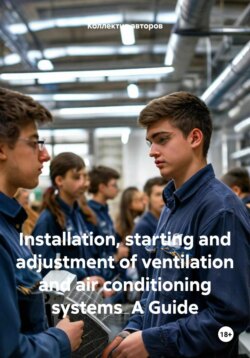Читать книгу Installation, starting and adjustment of ventilation and air conditioning systems A Guide - - Страница 2
Chapter II. Purpose and arrangement of ventilation systems
Purpose of ventilation systems
ОглавлениеThe state of the air is characterized by its main parameters: temperature, relative humidity, mobility (speed).
A person feels good only in a fairly narrow range of combinations of various air parameters.
The air parameters can be optimal, at which a person feels comfortable, and acceptable, at which a person's well-being and productivity of his work differs slightly from optimal. Thus, for industrial premises in the cold period of the year, the following optimal air parameters are set for medium-heavy work: temperature 18–20 °C, relative humidity 40–60% and mobility no more than 0.2 m/s.
The permissible air parameters for the same conditions have a wider range: temperature 17–23 °C, relative humidity no higher than 75% (the lower edge is not limited) and mobility no more than 0.3 m/s. In industrial premises, the maintenance of permissible air parameters is most often provided for.
Production processes may be accompanied by the release of harmful gases and vapors to humans into the air of the working area of the premises, the amount of which depends on the characteristics of the technological process, the degree of sealing of equipment, etc. The content of harmful gases and vapors in the air of the working area should not exceed the maximum permissible concentration (MPC). The maximum permissible concentration is the maximum possible amount of a harmful substance, mg/m3, per unit volume of air, which during the entire working experience does not cause diseases or abnormalities in the health of people working in these conditions, and does not affect subsequent generations. In addition, a large amount of heat, as well as moisture and dust can come from the process equipment. The person involved in the production process is a generator of heat, moisture and carbon dioxide. The heat output of one worker to the environment is 150–300 Watts or more. Every hour from 60 to 400 g of water vapor evaporates from the surface of the human body. Respiratory system produces from 20 to 40 liters of carbon dioxide.
These hazards in the form of excess heat, moisture, harmful gases and vapors enter the surrounding air and blendes in, while its temperature, moisture content, gas content, dustiness increase. This involves changes in the chemical composition and physical properties of the air.
In order to maintain normal air parameters in the premises that meet sanitary and hygienic and technological requirements, we implement ventilation, which creates an organized air exchange-removes polluted air and supplies treated (heated or cooled, humidified or drained) fresh and clean air instead.
Ventilation in most cases can provide only acceptable sanitary and hygienic conditions in the premises. The air parameters, strictly defined by temperature and relative humidity, including optimal ones, can be reached by using air conditioning systems.
